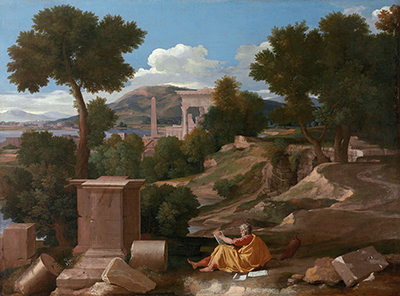The Landscape with St. John on Patmos is a neoclassical painting created by Nicolas Poussin in 1640. It is an oil on canvas painting and is currently housed at the Art Institute of Chicago.
Nicolas Poussin was a revered and intellectual French Classical Baroque painter who, however, spent most of his entire working life in Rome. The setting of the artwork is in Patmos, a Greek island. The background shows a sunny sky, sunny hills as well as a beautiful view of the mainland. Patmos, however, is an open landscape in ruins. The landscape is so extensive that an older man seems isolated in the foreground. The powerful old man in the painting is Saint John, one of the four evangelists who wrote the New Testament Gospels. He was banished to Patmos by Domitian, the Roman Emperor for his Christian beliefs. He is seated next to an eagle, reclined as he writes his divine inspiration on the gospels and the book of Revelation.
In the painting, Poussin also included a winding path and beautiful oak trees even amid scattered stones and fragments of the temple. There is no doubt that he carefully created the perfect environment for the Saint to depict the disappearing splendour of the ancient world. The Landscape of Saint John on Patmos illustrates the changes in philosophy and religion that liberated the world from the ancient pagan religions and into the future of Christianity. The ancient building ruins symbolise the destruction of the old beliefs and that the new vision (Christianity) is coming. Poussin uses artistic techniques to present his ideas on the changing beliefs about the world Saint John lived in as well as his strong Christian beliefs. He intellectually acquaints the public with a glimpse of his mind using this masterpiece.
The Landscape with Saint John on Patmos is a piece that is part of a pair. The other one being the 'Landscape with Saint Matthew and the Angel' which is currently housed in Berlin. Poussin painted both landscapes as the King's first painter just before returning to Paris. However, he quickly left this official post and later resumed his independent career in Rome. In both, he places the evangelists and their symbols in a landscape characterised by ruins of ancient buildings suggesting a philosophical continuity between the Greco-Roman world and new vision of Christianity. Conclusion Throughout Nicolas Poussin's Landscape with Saint John on Patmos, he has harmoniously expressed his ideas while artistically acknowledging the power of Christianity.




